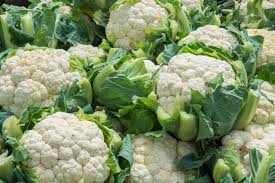
Cauliflower is one of several vegetables of the Brassica oleracea species of the genus Brassica, which belongs to the Brassicaceae family. It is an annual plant that reproduces from seeds. Usually only the head is eaten, the edible white meat sometimes called “curd”. Cauliflower is closely related to broccoli, turnips, rutabagas, brussels sprouts, kale and cabbage. Hundreds varieties of cauliflower are available today which differ in color, size, shape, taste and nutritional composition.
100 g of raw cauliflower contains 5 g carbohydrates and 25 calories.
Cauliflower can grow from 8 to 30 inches both in height and width.
Green cauliflower is referred to as broccoflower. It can be found in a normal curd-shaped form as well as in a spiky variant called Romanesco broccoli.
Cauliflower develops large and coarse leaves that are green in color. They grow in the form of rosette.
Orange cauliflower is known to be highly nutritious and may contain an immense amount of vitamin A, as compared to the white variety.
Leaves surround stalk which holds centrally positioned large, white head.
Cauliflower contains vitamin C, manganese, vitamin E, and other potent antioxidants that help in imparting nourishment to the body.
White head looks like a miniature tree on the cross section. It consists of densely packed curds. Head is usually 6 inches wide and has 2 to 3 pounds of weight in large varieties of cauliflower. Head consists of central stalk which branches and holds undeveloped flower buds.
Cauliflower also contains phytochemicals, called indoles and glucosinates, namely glucobrassicin, glucoraphanin, and gluconasturtiin.
Leaves ensure development of white head. Without leaves, bunch of inedible yellow flowers would appear.
Regular consumption of cauliflower can help with blood circulation and might help maintain the proper functioning of the blood vessels, which can be attributed to the presence of glucoraphanin.
Color of the head depends on the variety. Most common type of cauliflower is white, but it can be also purchased in green, purple, orange, brown and yellow color.
Cauliflower is a source of dietary fiber that can aid in digestion and promotes the elimination of toxins from the body.
Green variety is known as broccoflower because it looks like broccoli. One type of green cauliflowers develops spiky instead of round curds. This variety of cauliflower is known as Romanesco broccoli.
Vitamin C present in cauliflower helps to better absorb iron in the blood. This can help to increase the production of hemoglobin in the body.
Cauliflower belongs to the group of cruciferous vegetables. They are named that way because they have flowers that consist of four petals which grow in the shape of Greek cross.
Cauliflower contains vitamin C, which can play an important role in the production of collagen that protects the joints and bones from inflammatory damage and can even help in the treatment of rheumatoid arthritis.
Cauliflower develops from seeds and tissue transplants.
Cauliflower contains indole-3-carbinol, a phytonutrient that, along with sulforaphane, can help in activating and regulating the function of detoxifying enzymes responsible for metabolizing and eliminating harmful compounds from the body.
Depending on the variety, it takes from 50 to 265 days from planting of the seed to the harvest. Cauliflower is harvested when it reaches expected size and texture.
Studies have shown that sulforaphane present in cauliflower is effective in protecting the skin against the damage caused by ultraviolet radiation.
Cauliflower is an excellent source of dietary fibers, vitamins C, K and vitamins of the B group and minerals such as manganese, potassium and magnesium. Cauliflower has low caloric value and can be used as a substitute for rice and potato.
The potassium content in cauliflower may help in maintaining the electrolyte balance in the body,
Cauliflowers can be eaten raw, cooked or pickled.
Cauliflower is rich in antioxidants and immune-strengthening nutrients.
Prolonged cooking destroys majority of vitamins and it is associated with bad, sulfur-like smell of cauliflower. Cooking of 30 or more minutes decreases health benefits of cauliflower for 75%.
Cauliflower contains indoles, which possess anti-obesity effects.
Medical studies revealed that substances isolated from cauliflower can prevent development of certain types of cancer.
Cauliflower contains choline and phosphorous, which are both effective in repairing cell membranes.
China is the greatest manufacturer of cauliflowers in the world.
Regular intake of cauliflower may help in reducing the risk of diabetes due to the presence of vitamin C and potassium.
Cauliflower is an annual plant which means that it completes its life cycle in one year.









